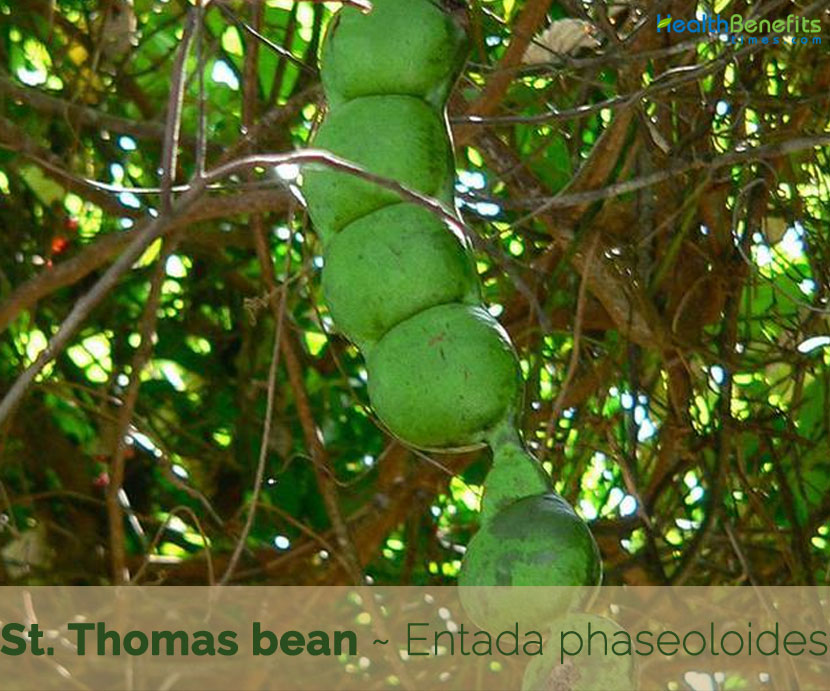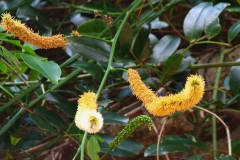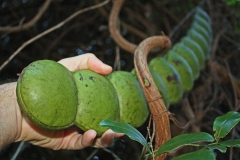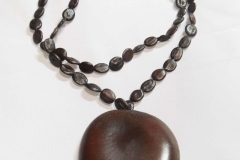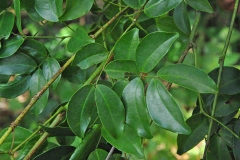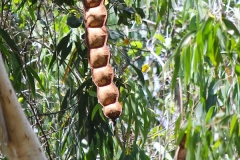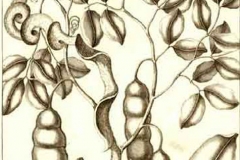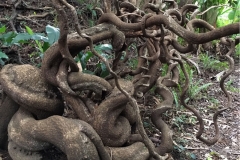| St. Thomas bean Quick Facts | |
|---|---|
| Name: | St. Thomas bean |
| Scientific Name: | Entada phaseoloides |
| Origin | Tropical Africa, tropical Asia and Malaysia and tropical north Australia |
| Colors | Green when young turning to brown as they mature |
| Shapes | Characteristic pods can grow very large, up to 2 m (6 ft 7 in) long and 130 mm (5.1 in) wide, somewhat curved, slightly constricted between the seeds |
| Taste | Bitter, acrid |
| Health benefits | Beneficial for rheumatic joint, muscle pains, respiratory ailments, hernia, gonorrhea, ulcers, headache, colic, constipation and fever |
| Name | St. Thomas bean |
|---|---|
| Scientific Name | Entada phaseoloides |
| Native | Tropical Africa: Sierra Leone to Tanzania, Madagascar; tropical Asia: India to South China and Malaysia and tropical north Australia. It was probably introduced to Mexico |
| Common Names | Cali Bean, Calinut, Elephant creeper, Elva, Elva Climber, Garbee Bean, Gila Bean, Go-go, Go-go Vine, Gogo, Mackay Bean, Matchbox Bean, Go-go, Monkey Ladder Pod, Nicker Bean, Sea Bean, Sea Heart, St Thomas Bean, sword bean |
| Name in Other Languages | Assamese: Bor gilla, Ghila, Gila lewa, Gilar lot Bengali: Gilagach, Gilla, Pangra Brazil : Cipó-Da-Beira-Mar Burmese: Dobin, Nyin Chinese: Kē téngzi (榼藤子), Guò jiāng long (過江龍), Ke Teng Columbia : Bejuco Parta, Cobalonga, Habo, Ojo De Buey, Parta English: Cali bean, Elephant creeper, Elva climber, Gila bean, Gogo vine, Matchbox bean, Monkey ladder pod, St. Thomas bean, sword bean French: Entada de Formose, Coeur de la mer, Coeur de singe, Liane géante, Wawa Garo: Chhui, Shuri, Sue Budu German: Pangraschote, Riesenhülse, Seeherzen, Seebohnen, Trockenblumen, Westindische Haselnuß, Westindische Haselstrauch Hindi: Barabi (भरबी), Chian Indonesia : Bendoh, Gandu, Chariyu Kannada: Chappebelli, Doddakampi, Haleballi, Halle, Hallebilu, Hallekayiballi, Palleburu Malay: Akar belu, Akar beluru, Akar belerang, Akar kupang, Bendoh (Java), Gandu, Sentok, Sintok Malayalam: Ahakkatela, Anatata, Entada, Kakavalli, Kakkavalli, Makkanka, Paranta, Parin- Perunkakkavalli, Paranda, Paringakavalli, Paringakakavully, Perimkakuvalli, Perumkakkavalli, Vattavalli Manipuri: Kangkhil Marathi: Garambi (गारंबी), Garbe, Girambi Mexico : Alampepe Oriya: Giridi Philippines : Tamayan, Balonos, Gogo, Bayogo, Kessing, Kezzing, Dipai, Lipai, Lipay, Balugo, Gogong-Bakai, Gogong-Bakay, Gugu, Gogo, Barugo, Barugu, Bayogo, Gogo, Balugo, Bayogo, Gogo, Gugo, Gugu Portuguese: Cipó-da-beira-mar Russian: Entada fasolevidnaia (Энтада фасолевидная), Entada formozanskaia (Энтада формозанская) Samoa : Tupe Sanskrit: Prthvika, Gilla Spanish: Alampepe, Bejuco parta, Cobalonga, Habo, Ojo de buey, Parta Sri Lanka : Maha Puswel, Maha Pusvael Sundanese: Chariyu Tagalog: Gogo Tamil: Anaittellu, Camuttirappuliyan, Cillu, Irikki, Kirancakamirakkoti, Kirancakamiram, Nukkuki, Nukkukikkoti, Ottolakkoti, Ottolam, Perumancati, Peruntellu, Peyarttavakkoti, Peyarttavam, Sillu, Tel, Tellu, Tellukkoti, Viccali, Viccalittellu, Yanaittellu Telegu: Gila tiga, Gilatige, Peddamadupu, Tandramanu, Tikativva Thai : Maba, Kam Ton, Saba Tonga : Pa’anga |
| Plant Growth Habit | Large, woody, branched, evergreen climbing vine |
| Growing Climates | Wide variety of habitats, ranging from freshwater swamp and inland from the mangrove up to montane forest |
| Plant Size | 100 m long and 18 cm in diameter |
| Bark | Dark brown and rough |
| Types |
|
| Stem | Thick as a man’s arm, angled, and much twisted |
| Leaf | Leaves 10–25 cm, on short petiole and tripinnate, the apical pair transformed into a long tendril. Pinnae stalked, usually 4 in number with oblong, elliptic or narrowly obovate, 2.5–5 cm long, coriaceous, glabrous, simple leaflets. Leaflets are somewhat elliptical, between 25 and 100 mm (0.98 and 3.94 in) long and 10 to 60 mm (0.39 to 2.36 in) wide |
| Flower | Flowers are between 2–3.5 mm (0.079–0.138 in) long, yellowish white, either crowded in long slender spikes from the axils of the upper leaves or arranged in terminal panicles. It is slightly fragrant and has 5 toothed, campanulata calyxes |
| Fruit Shape & Size | Characteristic pods can grow very large, up to 2 m (6 ft 7 in) long and 130 mm (5.1 in) wide, somewhat curved, slightly constricted between the seeds. |
| Fruit Color | Green when young turning to brown as they mature |
| Seed | Seeds are hard, and circular, with their sides flattened, about 5 centimeters across, and chocolate brown |
| Propagation | By seeds or air-layering |
| Taste | Bitter, acrid |
| Plant Parts Used | Bark, seeds and vines |
| Precautions |
|
Leaves
Leaves are 10–25 cm, on short petiole and tripinnate, the apical pair is transformed into a long tendril. Pinnae stalked, usually 4 in number with oblong, elliptic or narrowly obovate, 2.5–5 cm long, coriaceous, glabrous, simple leaflets. Leaflet are somewhat elliptical, between 25 and 100 mm (0.98 and 3.94 in) long and 10 to 60 mm (0.39 to 2.36 in) wide. Spikes are 15–25 cm, solitary or arranged in a panicle, villous with pubescent bracts.
Flowers
Flowers are between 2–3.5 mm (0.079–0.138 in) long, yellowish white, either crowded in long slender spikes from the axils of the upper leaves or arranged in terminal panicles. It is slightly fragrant and has 5 toothed, campanulata calyxes. Stamens are white, slightly longer than corolla. Ovary is glabrous with a filiform style.
Fruits
Fertile flowers are followed by characteristic pods that can grow very large, up to 2 m (6 ft. 7 in) long and 130 mm (5.1 in) wide, somewhat curved, slightly restricted between the seeds. Each pod consists of between 10 and 20 reddish brown seeds that are circular, hard and lens-shaped with their sides flattened and about 40 to 60 mm (1.6 to 2.4 in) in diameter. These chocolate-brown hued seeds are used by locals medicinally. As with a wide variety of other folkloric herbs, every part of the St Thomas bean may be used therapeutically, with each constituent part possessing its own medicinal value and curative property.
Health benefits of St. Thomas Bean
These are some of the popular health benefits of using St. Thomas bean
1. Anti-cancer
Saponin extracted from Entada phaseoloides seeds can efficiently protect cell membrane and prevent cell aging, dilate blood vessels, lower blood pressure and blood sugar, improve liver cell protein and DNA synthesis, and most importantly it can considerably prevent the growth of cervical cancer.
2. Prevents Bleeding
Powdered St. Thomas bean seeds are taken with congee to stop bleeding caused by hemorrhoids. Entada phaseoloides seed and honey locust seed are roasted and powdered; the powder is taken with warm wine to treat gastrointestinal bleeding.
Traditional uses and benefits of St. Thomas bean
- The plant is used against rheumatic joint and muscle pains, respiratory ailments, hernia, fish poisoning, gonorrhea, various skin ailments, ulcers, headache, colic, etc.
- Juice of the stem is drunk to relieve rheumatic joint and muscle pains, and to treat respiratory ailments.
- Decoction of the stem is drunk for the treatment of hernia, fish poisoning and gonorrhea.
- Saponin content of the stems makes them useful as a wash to treat a range of skin disorders.
- Juice of the roots is given for ulcers, abdominal muscle spasms and headaches.
- Fruits are considered as a contraceptive.
- Kernels of the seeds are mashed and used for poultices for children having colic.
- Juice proper of the bark used for conjunctivitis in Philippines.
- The Ayta communities in Dinalupihan, Bataan, used pounded stems as soap for dandruff and cleaning wounds.
- Paste of seeds applied to inflammatory glandular swellings in the axilla, pains of the loins and joints, swelling of the hands and feet when caused by general debility.
- Plant has been used in traditional system of medicine in Asia.
- Seeds are considered tonic, emetic, anti-periodic and anthelminthic.
- Seeds and bark are rich in saponins and have been used as hair wash and soap.
- Decoction of the seed paste has been used for washing wounds and itches.
- Pods have been used for chest complaints and a poultice of pulverized seeds used as poultice to relive painful inflammations and administered internally for constipation, contraception, snake bites, enterosis, abdominal complaints and colic in children and as aphrodisiac.
- Paste of the seeds is applied to relieve inflammatory glandular swellings in the axilla known as Khaka Bilari in India.
- Bark powder is used for stomach ulcer and the seed powder in fever and headache.
- Juice from the stem is drunk to treat a feverish abdomen and dysentery.
- Roasted seeds are eaten by women as a depurative in post-partum and are administered in small doses for stomachache, as an emetic, and are a component in some compound medicines.
- In the Philippines a decoction of the roots is drunk to treat a rigid abdomen.
- Smashed seeds are used to poultice abdominal complaints, such as colic of children.
Culinary Uses
- Seeds are soaked and roasted prior to eating.
- Roasted seeds are used as a coffee substitute.
- Young leaves can be eaten as a vegetable in India and Indonesia.
- Although poisonous raw, the seeds can be reduced edible by prolonged soaking and roasting.
- The seeds are edible cooked.
- Leaves are eaten both raw and cooked.
- Edible oil is obtained from the seed.
- Sap exuding from the cut branches is used as a drink.
- Thomas bean is cultivated for food and detergent production in the Philippines, India to South China and Java.
- Seed kernels are eaten after removal of the hard seed coats and after careful preparation by boiling or roasting.
- In India, the boiled seeds are consumed by Kharib tribes of Assam and Ocean tribes such as Onges and Great Andamanese.
- Soaked seed kernels are roasted, boiled and eaten by northeast tribal groups such as Garo, Khasi, Naga and Kannikkars of Tamil Naidu and Kerala.
- Half-ripened seeds are used as coffee substitute in South America.
Other Facts
- Seeds also yield edible oil that can also be used as a fuel and for illuminant oil in lamps.
- Plant is rich in saponins and is used for washing the hair and as detergent.
- It can be grown from seed but the seed has a hard seed coat that needs to be cut prior to sowing.
- The large seeds are used as beads in necklaces etc.
- Cut in half, the empty seed-coats can be used to make leg-rattles for dancers.
- Seeds are also used in games, as baby teeters, and as match boxes.
- Hollowed out seeds have also been used to make snuff boxes.
- Fibers from the bark are manufactured into ropes, sails and nets.
- Whole plant is rich in saponin and is used for washing the hair, as a detergent etc.
- When soaked in water and rubbed, the strips produce a lather which cleanses the scalp very effectively.
- The bark is a source of tannins.
- Thomas bean is cultivated for food and detergent production in the Philippines, India to South China and Java.
- Fresh liana has been used for making fish traps, the seeds used as fish poison in the Philippines.
- The seed oil is used as fuel.
- Seeds have been used for polishing and in games.
- When strung together the seeds are used as anklets, part of the kailao dance costume in Tonga.
- In Manipur, the seeds are used in making rosaries.
- They were also used as playing pieces in an ancient disc-throwing game, lafo.
- Stems are dried and pounded to make hair wash.
- It is believed to be the world’s largest legume.
References:
https://www.itis.gov/servlet/SingleRpt/SingleRpt?search_topic=TSN&search_value=502304#null
https://pfaf.org/user/Plant.aspx?LatinName=Entada+phaseoloides
https://plants.usda.gov/core/profile?symbol=ENPH#
https://en.wikipedia.org/wiki/Entada_phaseoloides
https://npgsweb.ars-grin.gov/gringlobal/taxonomydetail.aspx?id=411955
https://bie.ala.org.au/species/http://id.biodiversity.org.au/node/apni/2914070
https://www.wikidata.org/wiki/Q3281753
http://www.stuartxchange.org/Gogo.html
https://wikivisually.com/wiki/Entada_phaseoloides
http://en.hortipedia.com/wiki/Entada_phaseoloides
https://gd.eppo.int/taxon/ENTPH


